
- Usage in publication:
-
- Wolfcamp formation
- Modifications:
-
- Biostratigraphic dating
- AAPG geologic province:
-
- Permian basin
Summary:
Pg. 15-22. Included UDDENITES zone in Wolfcamp formation, Marathon region, western Texas. [Age is Permian.]
Source: US geologic names lexicon (USGS Bull. 896, p. 2360).
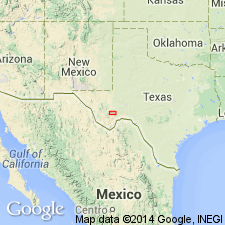
- Usage in publication:
-
- Wolfcamp formation
- Modifications:
-
- Original reference
- AAPG geologic province:
-
- Permian basin
Summary:
Pg. 41, pl. 3. Wolfcamp formation. Mostly shale, varying from almost black to gray and greenish gray. Interbedded are several layers of limestone which are cemented shell breccias, in places conglomeratic. There are also layers of calcareous sandstone. At Wolfcamp is 92 percent shale, 6 percent limestone, and 2 percent calcareous conglomerate. Thickness 500 feet at Wolfcamp, which is greatest known thickness in Glass Mountains. Unconformably underlies Hess formation and overlies Gaptank formation, with unconformity, E. Bose and J.W. Beede believe. Fossils from basal part [listed; include ammonite UDDENITES MINOR] indicate, in Bose's opinion, considerable time interval between Gaptank and Wolfcamp. [Age is Permian.]
Named from Wolfcamp, the site of an old dwelling place just south of the two buttes [now called Wolf Camp Hills], located 6.5 mi east and 2 mi north of east end of Leonard Mountain, and now marked by an old open well 100+/- feet deep, [Wolf Camp Hills 7.5-min quadrangle, Brewster Co., Marathon region, western TX]. [Considered the type locality by later workers.]
Source: US geologic names lexicon (USGS Bull. 896, p. 2360).

- Usage in publication:
-
- Wolfcamp formation
- Modifications:
-
- Biostratigraphic dating
- Overview
- AAPG geologic province:
-
- Permian basin
Summary:
Pg. 16, footnote. Wolfcamp formation was named by Bose, Baker, and Udden. Includes UDDENITES zone. [Age is Permian.]
[Possible misprint in USGS Bull. 896 (p. 2360)? Lists Univ. Texas Bull. 1762. The Geologic literature of North America 1785-1918 (J.M. Nickles, 1923, USGS Bull. 746) lists Emil Bose, 1917, The Permo-Carboniferous ammonoids of the Glass Mountains, west Texas, and their stratigraphic significance, Univ. Texas Bull. 1762, 241 p., and J.A. Udden, 1917, Notes on the geology of Glass Mountains, Univ. Texas Bull. 1753, p. 3-59, map. For now, this is cited as a footnote IN Bose's (1917) publication.]
Source: US geologic names lexicon (USGS Bull. 896, p. 2360).

- Usage in publication:
-
- Wolfcamp formation
- Modifications:
-
- Revised
- Areal extent
- AAPG geologic province:
-
- Permian basin
Summary:
Pg. 383-400. Wolfcamp formation does not have a basal conglomerate at type locality, where it is 475 feet thick, but to southwest, where it overlaps upon much-folded formations, its thickness attains 600 feet, of which 400 feet are conglomerates. Writer believes UDDENITES zone belongs to Wolfcamp, but Keyte, Blanchard, and Baldwin believe it belongs to Gaptank. Absent in Del Norte Mountains but present throughout Glass Mountains, Marathon region, western Texas. [Age is Permian.]
Source: US geologic names lexicon (USGS Bull. 896, p. 2360).
- Usage in publication:
-
- Wolfcamp formation
- Modifications:
-
- Revised
- AAPG geologic province:
-
- Permian basin
Summary:
Pg. 148. UDDENITES and overlying limestone members are in this report included in Gaptank formation (Pennsylvanian) instead of in Wolfcamp formation (Permian).
Source: US geologic names lexicon (USGS Bull. 896, p. 2360).
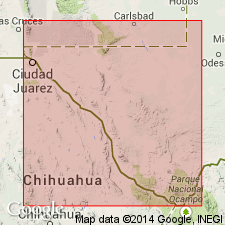
- Usage in publication:
-
- Wolfcamp formation*
- Modifications:
-
- Revised
- AAPG geologic province:
-
- Permian basin
Summary:
Wolfcamp formation. Tentatively drew base of Wolfcamp formation at top of UDDENITES zone, and treated the overlying gray limestone as basal bed of Wolfcamp formation. He believed the unconformity reported at top of the gray limestone is debatable. [Age is Permian.]
Source: US geologic names lexicon (USGS Bull. 896, p. 2360).

- Usage in publication:
-
- Wolfcamp formation
- Modifications:
-
- Overview
- AAPG geologic province:
-
- Permian basin
Summary:
In [post-1917] reports the UDDENITES zone has been included in Wolfcamp formation by some writers and in Gaptank formation by other writers. See under Gaptank formation.
Source: US geologic names lexicon (USGS Bull. 896, p. 2360).
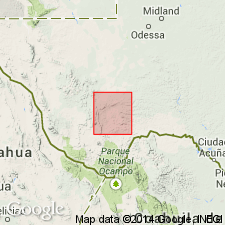
- Usage in publication:
-
- Wolfcamp formation*
- Modifications:
-
- Revised
- AAPG geologic province:
-
- Permian basin
Summary:
Pg. 94-97. Wolfcamp formation. Is oldest formation of Glass Mountains section and crops out in scattered exposures in southern foothills of the mountains. In western part of mountains, it rests with strong unconformity on older Paleozoic rocks of Marathon basin. To the east, this unconformity is no longer evident, and formation rests with no marked difference in dip or strike upon higher members of the Pennsylvanian. Top of formation is everywhere well-marked plane of unconformity, by which it is separated from succeeding Leonard formation. Udden (1917) separated the Wolfcamp from uppermost Pennsylvanian (Gaptank) formation on the basis of fossils of Permian aspect collected at type locality. Section at Wolf Camp, as shown by Udden, includes at base shales and limestones of Pennsylvanian age, succeeded by 100 feet of shale containing ammonoids described by Bose as UDDENITES fauna. These in turn are succeeded by a thick-bedded limestone which is here considered to be basal bed of Wolfcamp formation. Above this are several hundred feet of shales and thin limestones, which extend up to basal conglomerate of overlying Leonard formation. Since original work in the area, the Wolfcamp formation and its fossils have been studied by many geologists. Upper part of formation has been generally considered to be of Permian age, but shale containing UDDENITES fauna has been interpreted by some paleontologists as uppermost Pennsylvanian and by others as lowermost Permian. It is here included in Gaptank formation and considered to be Pennsylvanian. Wolfcamp formation north of Wolf Camp is 583 feet thick and consists of lower gray limestone member, 49 feet thick, and upper shale member, 534 feet thick. Fossils listed at type seetion.
Source: US geologic names lexicon (USGS Bull. 1200, p. 4278-4280).
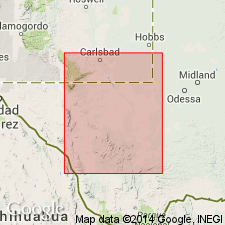
- Usage in publication:
-
- Wolfcamp formation
- Modifications:
-
- Not used
- AAPG geologic province:
-
- Permian basin
Summary:
Pg. 1674-1675, 1677. Permian system divided into four divisions of series rank. Wolfcamp is first and lowest of these divisions. Comprises beds that have been referred to as Wolfcamp formation (restricted), which is thus raised to series rank. In Glass Mountains, series consists of about 600 feet of limestone, limestone conglomerates, and shales. In West Texas, Wolfcamp rests with angular unconformity on rocks ranging in age from Precambrian to upper Pennsylvanian and is unconformably overlain by Leonard series. Characterized by fusulind genera SCHWAGERINA s. s., PSEUDOSCHWAGERINA, and PARASCHWAGERINA. Wolfcamp equivalents include Hueco formation (restricted) of Diablo Plateau and Abo formation of New Mexico. Series in northern Oklahoma, Kansas, and Nebraska includes beds from disconformity above Brownville limestone up to horizon near top of Herington limestone. Recommended that in Oklahoma term Wanette be dropped in favor of Wolfcamp series.
Source: US geologic names lexicon (USGS Bull. 1200, p. 4278-4280).
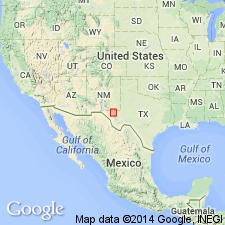
- Usage in publication:
-
- Wolfcamp series*
- Wolfcamp formation*
- Modifications:
-
- Areal extent
- AAPG geologic province:
-
- Permian basin
Summary:
Pg. 556-566, 646-650. Wolfcamp series is not exposed in Guadalupe Monntains but comes to surface in Sierra Diablo; here it is represented by Hueco limestone. Local representative of series is Wolfcamp formation, which is about 600 feet thick and consists of alternating thick beds of shale and thin beds of limestone. Base of formation is defined as bottom of gray limestone member about 45 feet thick, which lies directly on UDDENITES-bearing shale member at top of Gaptank formation. At type locality and elsewhere in Glass Mountains, Wolfcamp formation is unconformably overlain by Leonard formation of Leonard series.
Source: US geologic names lexicon (USGS Bull. 1200, p. 4278-4280).
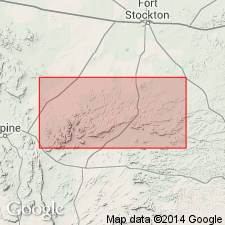
- Usage in publication:
-
- Wolfcamp formation
- Modifications:
-
- Not used
- AAPG geologic province:
-
- Permian basin
Summary:
Pg. 299-311. Wolfcamp series in Glass Mountains, [Brewster County], western Texas, is represented by sequence of diverse lithologies and includes regional unconformity. Detailed study reveals that two formations can be recognized in field and that both units are within "zone of PSEUDOSCHWAGERINA." Each formation has characteristic fusulinid fauna. Nealranch [Neal Ranch] formation (new) embraces upper part of beds originally called Wolfcamp by Udden (1917) in Wolf Camp Hills and is renamed to retain this widely used name for time-stratigraphic unit, Wolfcamp series. Lenoxhills [Lenox Hills] formation (new) unconformably overlies Nealranch formation and is upper formation of Wolfcamp series in Glass Mountains. It was in part included in Wolfcamp formation of King (Univ. Texas Bull., no. 3080, 1931) where it crops out in western Glass Mountains and is now known to be present across southern escarpment of eastern Glass Mountains, and is lower 200 to 300 feet of Hess formation of Udden (1917). Exact placement of top of Pennsylvanian system in Glass Mountains has long been major controversy. Fusulinid faunas of Cisco (Virgil) age are known from strata as high as "grey limestone" of King (1931 and 1937). In Wolf Camp Hills, the Nealranch (300 to 470 feet thick unconformably) overlies the ''grey limestone" and contains oldest SCWAGERINA and PSEUDOSCHWAGERINA faunas thus far discovered in Glass Mountains. Boundary between Permian and Pennsylvanian systems is taken at this unconformity. The "grey limestone" of King (1931) contains youngest Pennsylvanian fauna in Wolf Camp Hills and includes TRITICITES COMPTUS n. sp., T. VENTRICOSIS (Moller), T. PINGUIS Dunbar and Skinner, and T. KOSCHMANNI Skinner.
Source: US geologic names lexicon (USGS Bull. 1200, p. 4278-4280).
For more information, please contact Nancy Stamm, Geologic Names Committee Secretary.
Asterisk (*) indicates published by U.S. Geological Survey authors.
"No current usage" (†) implies that a name has been abandoned or has fallen into disuse. Former usage and, if known, replacement name given in parentheses ( ).
Slash (/) indicates name conflicts with nomenclatural guidelines (CSN, 1933; ACSN, 1961, 1970; NACSN, 1983, 2005, 2021). May be explained within brackets ([ ]).

